Self-focusing
Definition: focusing of a beam in a transparent medium, caused by the beam itself through a nonlinear process in the medium
More general term: nonlinear optical effects
German: Selbstfokussierung
How to cite the article; suggest additional literature
Author: Dr. Rüdiger Paschotta
Due to a Kerr lens, an intense optical pulse propagating in a nonlinear medium can experience nonlinear self-focusing (or self-focussing): the beam diameter is decreased compared with that of a weak pulse. The physical mechanism is based on a Kerr nonlinearity with positive χ(3). In this situation, the higher optical intensities on the beam axis, as compared with the wings of the spatial intensity distribution, cause an effectively increased refractive index for the inner part of the beam. This modified refractive index distribution then acts like a focusing lens.
A related effect, occurring in the case of a negative χ(3) nonlinearity, is self-defocusing, where the Kerr lens has a reduced refractive index on the beam axis.
Self-focusing can also be caused by other effects, such as thermal lensing.
Consequences of Self-focusing
As the decrease in the beam radius further increases the strength of the Kerr lens, there may be total collapse of the beam: as the beam radius is reduced, the optical intensities become even higher, further increasing the self-focusing effect. This mechanism can lead to very high optical intensities which can easily destroy the optical medium (optical damage). Such a run-away effect can occur when the optical power is above the critical power
where n2 is the nonlinear index, λ the vacuum wavelength, and n the refractive index. This holds for linearly polarized light. For circularly polarized light, the self-focusing behavior can be substantially different [7].
Remarkably, the critical power does not depend on the original beam area. (A larger beam generates a weaker Kerr lens, but it is also more sensitive to lensing.) Only, an initially larger beam will require a longer propagation distance (for a given optical power) until it collapses. For silica (as used e.g. in silica fibers), the self-focusing limit in terms of peak power is of the order of 4 MW in the 1-μm wavelength region.
Note that the value used for the nonlinear index depends on the pulse duration. For shorter pulses, a somewhat lower value must be used, as there is not sufficient time for the effect of electrostriction and possibly for the delayed nonlinear response (→ Raman scattering).
In an optical fiber, the built-in waveguide forms guided modes. Self-focusing then reduces the effective mode area (see Figure 1). At the critical power (which is the same as for bulk material), the mode area approaches zero.
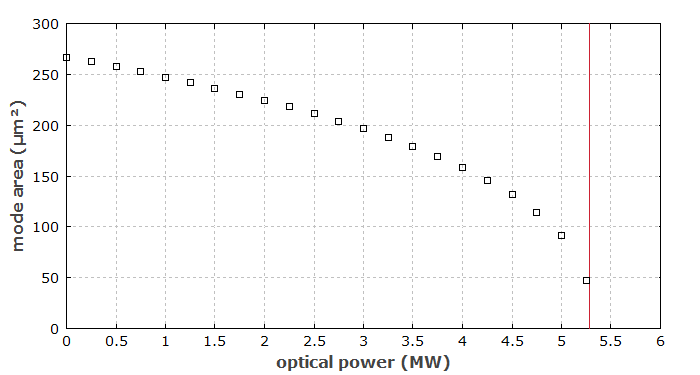
A beam in a homogeneous medium (i.e., with no waveguide) with a power exactly at the self-focusing limit could theoretically exhibit self-trapping [1], where the beam profile stays constant over a longer distance, because divergence is exactly compensated by the nonlinear focusing effect. That state, however, is unstable; small deviations from that state would grow rapidly.
Higher-order modes also become unstable as a consequence of the nonlinear interaction. Figure 2 shows an example, where a power of 4 MW has been injected into the LP11 mode of a fiber. After about 10 mm of propagation distance, the light is transferred into a mixture of LP01 and LP11.
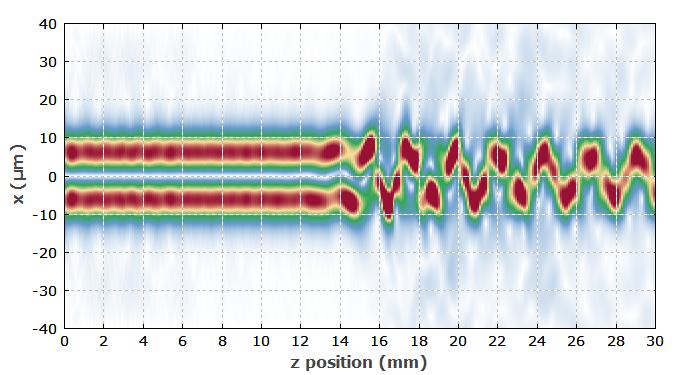
For optical powers far above the self-focusing limit, filamentation can occur, where the beam breaks up into several beams with smaller powers. The resulting beam pattern can be random, but in some cases it has a fairly regular structure.
Different dynamics (transient self-focusing [3]) occur for ultrashort pulses when the pulse duration is not much longer than the characteristic time scale of the nonlinearity [3].
The reduction in beam radius for high intensities (for peak powers below the self-focusing limit) can be used for Kerr lens mode locking of a laser, when it leads to a better overlap of laser and pump beam, or to reduced losses at some aperture. In both cases, it generates a kind of artificial saturable absorber.
Another application of self-focusing is the measurement of the magnitude of the Kerr nonlinearity (→ z-scan measurements).
Note that cascaded χ(2) nonlinearities (essentially, frequency doubling with subsequent backconversion) can also lead to an effective χ(3) nonlinearity, resulting either in self-focusing or (for negative effective χ(3)) self-defocusing.
Questions and Comments from Users
Here you can submit questions and comments. As far as they get accepted by the author, they will appear above this paragraph together with the author’s answer. The author will decide on acceptance based on certain criteria. Essentially, the issue must be of sufficiently broad interest.
Please do not enter personal data here; we would otherwise delete it soon. (See also our privacy declaration.) If you wish to receive personal feedback or consultancy from the author, please contact him e.g. via e-mail.
By submitting the information, you give your consent to the potential publication of your inputs on our website according to our rules. (If you later retract your consent, we will delete those inputs.) As your inputs are first reviewed by the author, they may be published with some delay.
Bibliography
| [1] | R. Y. Chiao, E. Garmire, and C. H. Townes, “Self-trapping of optical beams”, Phys. Rev. Lett. 13 (15), 479 (1964), doi:10.1103/PhysRevLett.13.479 |
| [2] | P. L. Kelley, “Self-focusing of optical beams”, Phys. Rev. Lett. 15 (26), 1005 (1965), doi:10.1103/PhysRevLett.15.1005 (see also the erratum in Phys. Rev. Lett. 16, 384 (1966)) |
| [3] | Y. R. Shen, “Self-focusing: experimental”, Prog. Quantum Electron. 4, 1 (1975), doi:10.1016/0079-6727(75)90002-6 |
| [4] | J. H. Marburger, “Self-focusing: theory”, Prog. Quantum Electron. 4, 35 (1975), doi:10.1016/0079-6727(75)90003-8 |
| [5] | G. Cerullo et al., “Space-time coupling and collapse threshold for femtosecond pulses in dispersive nonlinear media”, Opt. Lett. 21 (1), 65 (1996), doi:10.1364/OL.21.000065 |
| [6] | G. Fibich and A. L. Gaeta, “Critical power for self-focusing in bulk media and in hollow waveguides”, Opt. Lett. 25 (5), 335 (2000), doi:10.1364/OL.25.000335 |
| [7] | G. Fibich and B. Ilan, “Self-focusing of circularly polarized beams”, Phys. Rev. E 67 (3), 036622 (2003), doi:10.1103/PhysRevE.67.036622 |
| [8] | R. L. Farrow et al., “Peak-power limits on fiber amplifiers imposed by self-focusing”, Opt. Lett. 31 (23), 3423 (2006), doi:10.1364/OL.31.003423 |
| [9] | L. Dong, “Approximate treatment of the nonlinear waveguide equation in the regime of nonlinear self-focus”, J. Lightwave Technol. 26 (20), 3476 (2008), doi:10.1109/JLT.2008.925685 |
| [10] | A. V. Smith et al., “Optical damage limits to pulse energy from fibers”, J. Sel. Top. Quantum Electron. 15 (1), 153 (2009), doi:10.1109/JSTQE.2008.2010331 |
| [11] | D. E. Laban et al., “Self-focusing in air with phase-stabilized few-cycle light pulses”, Opt. Lett. 35 (10), 1653 (2010), doi:10.1364/OL.35.001653 |
| [12] | P. Whalen et al., “Self-focusing collapse distance in ultrashort pulses and measurement of nonlinear index”, Opt. Lett. 36 (13), 2542 (2011), doi:10.1364/OL.36.002542 |
| [13] | S. A. Kozlov et al., “Suppression of self-focusing for few-cycle pulses”, J. Opt. Soc. Am. B 36 (10), G68, doi:10.1364/JOSAB.36.000G68 |
| [14] | R. Paschotta, tutorial on "Passive Fiber Optics", Part 11: Nonlinearities of Fibers |
See also: Kerr effect, Kerr lens mode locking, z-scan measurements, B integral
and other articles in the category nonlinear optics
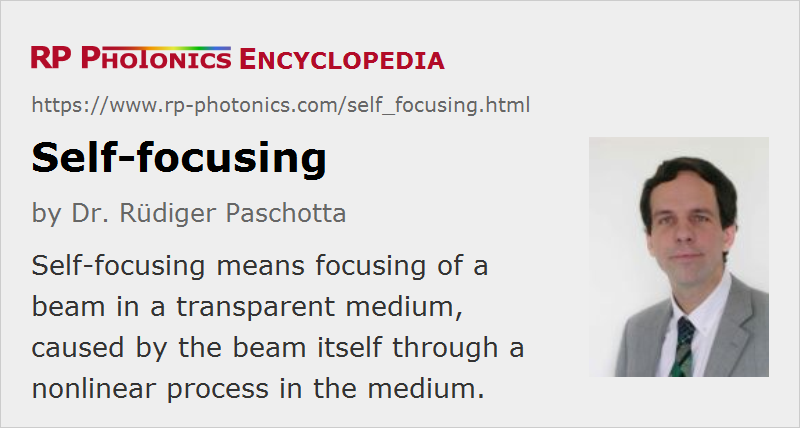 |



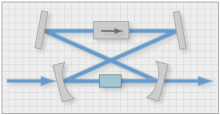
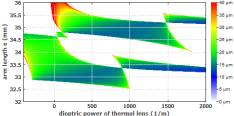
If you like this page, please share the link with your friends and colleagues, e.g. via social media:
These sharing buttons are implemented in a privacy-friendly way!